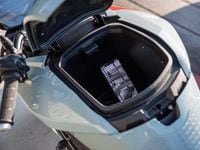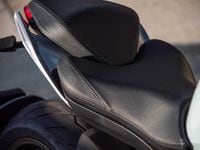Motorcycles have taken a few steps forward since Gottlieb Daimler and Wilhelm Maybach rolled out the first powered bike in 1885. And on a slightly smaller scale, Zero Motorcycles has quantum leaped several times since the brand was launched in Neal Saiki’s Santa Cruz, California, garage in 2006.
The apogee of the brand’s efforts—at least now the company is 14 years in—is the Zero SR/F, a prime example of what happens when a fringe manufacturer chips away at the art of bike building long enough to make significant strides in the game. First and foremost, there’s range: 161 miles in the city, or 99 miles at a constant 55 mph. Okay, so it’s not exactly the stuff of chasing the sunset into endless horizons. But Zero’s so-called Power Tank adds 3.6 kWh to the 14.4 kWh lithium-ion battery, expanding the city range up to 200 miles. The downside? The extra battery adds an additional 45 pounds on top of the bike’s already hefty near-500 pound curb weight. Houston, we have a (short) road trip.
Blur your eyes, and the SR/F’s color scheme might remind you of a certain internal combustion offering from the Red Wing brand. But the execution is fairly singular: From the new operating system (dubbed Cypher III) to the updated cellphone app interface, the bike’s customizable dashboard and up to 10 bespoke ride modes allow engine-braking, power delivery, and traction control threshold characteristics tailored to rider preferences. Not your daddy’s Einspur, indeed.
There’s a palpable heft when you lift the SR/F off its sidestand, a clear indicator that some static battery mass is required for kinetic movement. It’s not all bad though. With no reciprocating pistons or crankshafts to speak of, there’s no messing with the bike’s balance when it’s leaned over in a corner. The weight is also somewhat low, with the false tank offering a bit of surprise and delight in the form of a storage cubby with USB power outlets. Neat.
If shifting gears the conventional way is ingrained in your DNA, it might take a few electric miles to become accustomed to this setup. Brakes are in the usual place on the right grip and foot pedal, but there’s no clutch lever to speak of—the instinct to grab the clutch lever is strong, but you’ll be reaching for air. However, with no gears to select there’s a refreshingly linear, continuous transfer of power from the motor to the rear wheel, and here’s where it gets interesting. Rather than thinking of horsepower as a commodity that gets segmented by six gears, the flow is simply constant until it tapers off at the 110 mph top speed. Braking also becomes one with the acceleration mindset; when the SR/F is dialed in for aggressive regeneration (either via the 5-inch TFT panel or the cellphone app), you don’t grab the brake lever to slow down, you simply ease off the throttle to reduce the rate of acceleration until you’re scrubbing off speed. Not to get too cerebral, but an electric bike’s entire longitudinal axis becomes one fluid continuum, which has a way of fundamentally shifting the way you think about things like corner entry speeds, weight transfer, even racing line.
The first thing you’ll notice off the line is how the throttle intuitively responds to grip twists. Engine controller technology has progressed significantly from Zero’s early days, and there’s no second-guessing how much you’ll need to bend your wrist to yield the right amount of forward motion. Acceleration is accompanied by a slightly metallic-sounding tone, but is otherwise quiet—listen closely, and you might hear birds chirping (or pedestrians yelping as they cross blithely into the street because they didn’t hear you coming). Give the throttle a solid squeeze, and once you’re past the first few miles per hour you find yourself blasting forward at an incomprehensibly swift rate. One independent source clocked the SR/F’s 0 to 60 mph time in well under 2 seconds. We believe it.
The SR/F has also grown by leaps and bounds in the suspension department. Whereas early Zeros, especially dirt bike variants, felt like glorified mountain bikes, the SR/F offers legit moto hardware: 43mm Showa Big Piston fork up front and a Showa rear monoshock, all fully rebound and compression adjustable. While the Zero feels virtually weightless in a straight line, its strong, smooth bursts of seamless power urging it ahead as though it defies the very concept of drag and resistance, cornering is a slightly different story. Although considerably improved over earlier Zero iterations, the SR/F still feels a bit pokey at turn-in, requiring some forethought when ridden aggressively on canyon roads. It takes a bit of a nudge to get the front end pointed and the body set into the desired direction, but once settled into a corner the bike’s stability makes it feel like it’s on those proverbial rails you keep hearing so much about. Perhaps it’s less about the nearly 500-pound curb weight and more about the fact that the SR/F is tuned for stability; there’s often a trade-off between the two, and it’s clear which way Zero has swung in this equation.
The base SR/F starts at $19,495, which is already a pretty penny compared to the gas-powered competition attainable for 20 grand or so. Opting for the $21,495 Premium version gets you a 6 kW onboard charger for quicker juice-ups, a fly screen, heated grips, and aluminum bars; even faster charging is available for a $23,795 model equipped with a 12 kW charger. While Zero has covered considerable ground since the early days by bringing swappable batteries on some models and super-speedy recharge times in as little as 60 minutes from empty, the market for electric bikes is likely to see even more dramatic change in the coming years. Sure, players like Harley-Davidson are bringing some much-needed heat to the segment. But the truly desirable EVs (like a well-equipped SR/F in the mid-$20s or the LiveWire which comes in at $30,000) are still premium products for the well-heeled. The next wave of the electric revolution won’t just involve lighter battery packs and more range (though those advances can’t hurt). The big impact point will be affordability; we’ve come a long way in our battery-powered quest for swift and silent transportation, but the only way to fully contest the internal combustion establishment will be through price parity. Meet or beat the cost of the gas-powered competition, and you may as well find EVs like the Zero SR/F in every driveway.
Helmet: Schuberth C3
Jacket: Dainese Patina72
Gloves: Dainese Full Metal RS
Pant: Alpinestars Copper
Boots: Alpinestars J-Cult

























/cloudfront-us-east-1.images.arcpublishing.com/octane/HXOUJXQWA5HBHGRO3EMJIGFMVI.jpg)

/cloudfront-us-east-1.images.arcpublishing.com/octane/3TIWWRV4JBBOLDVGRYECVVTA7Y.jpg)
/cloudfront-us-east-1.images.arcpublishing.com/octane/KIX5O23D5NAIBGFXBN3327DKZU.jpg)
/cloudfront-us-east-1.images.arcpublishing.com/octane/7GJYDUIPXRGMTMQKN6ONYOLBOU.jpg)
/cloudfront-us-east-1.images.arcpublishing.com/octane/MUQLOVLL2ZDGFH25ILABNBXKTI.jpg)
/cloudfront-us-east-1.images.arcpublishing.com/octane/TNOU5DNE2BC57MFPMGN2EIDXAM.jpg)
/cloudfront-us-east-1.images.arcpublishing.com/octane/GTCXACQGJ5HAPDTGWUQKDEH44E.jpg)
/cloudfront-us-east-1.images.arcpublishing.com/octane/S35YGSEMEZB4BLTDJTSZPF4GLA.jpg)
/cloudfront-us-east-1.images.arcpublishing.com/octane/5UOT6HPX2JFMRJAX6EH45AR4MQ.jpg)
/cloudfront-us-east-1.images.arcpublishing.com/octane/OKWOJWAKP5EP3OACCRRWPCIX2Q.jpg)
/cloudfront-us-east-1.images.arcpublishing.com/octane/2WF3SCE3NFBQXLDNJM7KMXA45E.jpg)
/cloudfront-us-east-1.images.arcpublishing.com/octane/G4MG6OUCJNBSHIS2MVVOTPX65E.jpg)
/cloudfront-us-east-1.images.arcpublishing.com/octane/IIGGWFOTOJGB7DB6DGBXCCMTDY.jpg)
/cloudfront-us-east-1.images.arcpublishing.com/octane/QSTCM6AVEZA5JJBUXNIQ3DSOF4.jpg)
/cloudfront-us-east-1.images.arcpublishing.com/octane/U4I7G625B5DMLF2DVIJDFZVV6M.jpg)
/cloudfront-us-east-1.images.arcpublishing.com/octane/B6XD6LS6IVCQPIU6HXDJSM3FHY.jpg)
/cloudfront-us-east-1.images.arcpublishing.com/octane/ICL63FEDDRDTTMINYICCEYGMDA.jpg)
/cloudfront-us-east-1.images.arcpublishing.com/octane/FCGZHQXRBZFLBAPC5SDIQLVF4I.jpg)
/cloudfront-us-east-1.images.arcpublishing.com/octane/WNOB6LDOIFFHJKPSVIWDYUGOPM.jpg)

/cloudfront-us-east-1.images.arcpublishing.com/octane/X33NU3E525ECRHXLNUJN2FTRKI.jpg)
/cloudfront-us-east-1.images.arcpublishing.com/octane/6KKT5NNL2JAVBOXMZYS5ZO76YA.jpg)
/cloudfront-us-east-1.images.arcpublishing.com/octane/J5RKG5O455GMPGQRF2OG6LRT7A.jpg)